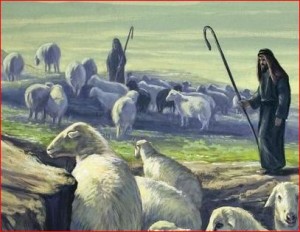I’ve already heard on TV and from several preachers that Jesus could not have been born in December because no one would keep sheep in the fields in the month of December because of the rainy season. One of my  professors at Dallas Seminary, Harold Hoehner, argues persuasively that this is nonsense. I like how Arnold Fruchtenbaum answers that question in the “Messianic Bible Study.” He says, “Anyone who says that has simply never been to the Bethlehem area in the month of December. Having lived in Israel, and having been in Bethlehem on more than one occasion in December, I can attest to the fact that there are sheep and shepherds everywhere. Israel’s rainy season is from mid-October to mid-April. From mid-April to mid-October, no rain falls in the country except on extremely rare occasions. As a result, by the time the first of October arrives, the hills and valleys are burned dry by the sun. Since the rains come in October, by the time December arrives, there is a lush, green carpet throughout the county, even in the Negev Desert. It is a great time for those sheep to be out there!”
professors at Dallas Seminary, Harold Hoehner, argues persuasively that this is nonsense. I like how Arnold Fruchtenbaum answers that question in the “Messianic Bible Study.” He says, “Anyone who says that has simply never been to the Bethlehem area in the month of December. Having lived in Israel, and having been in Bethlehem on more than one occasion in December, I can attest to the fact that there are sheep and shepherds everywhere. Israel’s rainy season is from mid-October to mid-April. From mid-April to mid-October, no rain falls in the country except on extremely rare occasions. As a result, by the time the first of October arrives, the hills and valleys are burned dry by the sun. Since the rains come in October, by the time December arrives, there is a lush, green carpet throughout the county, even in the Negev Desert. It is a great time for those sheep to be out there!”
Dr. Max Younce also defends the traditional date of Christ’s birth. He too quotes witnesses who were in Israel in December, “On December 25th the group observed sheep feeding in the fields on grass over a foot high. There was grass from Dan to Beersheba, even to Jericho, with cattle and sheep feeding. This is the time of the “greater rains” which ran from October through December. This is when our Lord was born in an empty stable.”
His argument is rather complicated and he bases his case on two Bible passages: 1 Chronicles 24:1-10, and Luke 1:23-27. He says, “In I Chronicles 24:1-10, there were 24 priests with two serving each month. Abijah served during the 8th order, which is the 4th month or July. (The first month in the Jewish calendar, Abib, is our April.) Read Luke 1:5, which is the same course found in I Chronicles 24. “Abijah” (Hebrew) and “Abiah’ (Greek) are the same. Therefore, Zachariah, the father of John the Baptist was serving his term during July. In Luke 1:23-27 we find Elisabeth conceived in either August or September. Her first month was September or October. Notice…in Elizabeth’s 6th month, February or March, the Virgin Mary conceived. Mary’s first month was March or April; therefore, her 9th month would be either November or December. Since the “greater rains” are in December, causing the grass to grow, it is fitting that Luke 2:8 should tell that the shepherds and their sheep were in the fields at the time of Christ’s birth.” Just because someone with a microphone and a camera pointed at them tells you it’s not so, doesn’t make it so! Just because there are a lot of letters after someone’s name, doesn’t guarantee the accuracy of their opinions. There is no compelling evidence to reject the traditional date of Jesus’ birth. Don’t let what you hear dampen your celebration of the birth of our Savior!